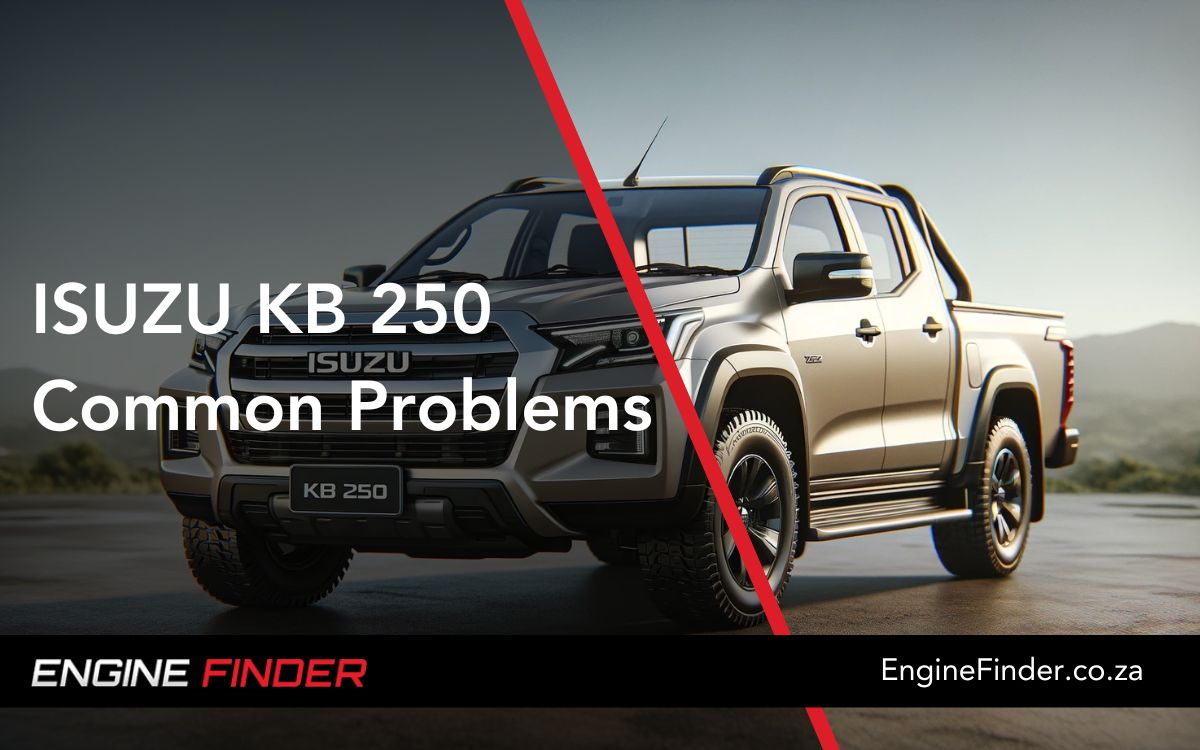
Isuzu KB250 Engine Problems: Complete D-TEQ Troubleshooting Guide
Key Takeaways
| Problem | Main Symptoms | Possible Causes |
|---|---|---|
| Automatic Gearbox Malfunctions | Unexpected disengagement, jerking | Worn linkage, torque converter, speed sensor |
| Brake Pedal Switch Issues | Engine light, limp mode activation | Faulty switch, loose connections, carbon buildup |
| High Fuel Consumption | Poor fuel economy, excessive usage | Over-tightened injectors, faulty suction control valve |
| Hot Starting Problems | Engine won’t start when hot | Glow plug issues, sensor problems, electrical faults |
| Brake Caliper Failures | Recurring brake problems | Caliper wear, hydraulic issues |
The Isuzu KB250 with its reliable D-TEQ 2.5-liter diesel engine has been a favorite among South African farmers and commercial users since its introduction. Known for ruggedness and durability, this pickup truck delivers solid performance with 85kW power and 280Nm torque. While generally dependable, the KB250 can experience specific issues that owners should understand to maintain optimal performance and prevent costly repairs.
Isuzu KB250 D-TEQ Engine Specifications
| Specification | Details |
|---|---|
| Engine Code | 4JA1-TC / 4JH1-TC |
| Displacement | 2.5L (2,499cc) |
| Configuration | Inline-4, SOHC, Turbocharged Diesel |
| Fuel System | Common Rail Direct Injection |
| Power Output | 85 kW (114 HP) @ 3,600 rpm |
| Torque Output | 280 Nm @ 1,800 rpm |
| Production Years | 2007-2017 |
1. Automatic Gearbox Malfunctions
Causes
- Worn Linkage: Mechanical linkage between gear selector and transmission wearing out.
- Faulty Torque Converter: Internal damage causing power transmission issues.
- Transmission Speed Sensor: Sensor providing incorrect signals to ECU.
- Hydraulic Pressure Problems: Low pressure causing poor gear engagement.
Symptoms
- Automatic gearbox disengaging unexpectedly during driving.
- Engine revving without forward propulsion.
- Aggressive jerking when gearbox re-engages.
- Delayed or harsh shifting between gears.
Solution
- Inspect and replace worn linkage components.
- Test torque converter operation and replace if faulty.
- Diagnose transmission speed sensor with scan tool.
- Check hydraulic pressure and service transmission as needed.
DIY Difficulty / Hours
- Linkage Inspection: Medium difficulty / 2-3 hours
- Sensor Replacement: High difficulty / 3-4 hours
- Professional Service: R1,500 - R3,500 for sensor. R8,000 - R25,000 for major repairs.
Gearbox Warning
Never ignore sudden gearbox disengagement. This can be dangerous and indicates serious transmission problems requiring immediate professional attention.
2. Brake Pedal Switch Issues
Causes
- Faulty Brake Switch: Internal electrical failure of brake pedal switch.
- Loose Connections: Corroded or loose electrical connections.
- Carbon Buildup: Carbon deposits on connection points affecting signal.
- Wiring Problems: Damaged wiring harness to brake switch.
Symptoms
- Engine warning light illuminating unexpectedly.
- Vehicle entering limp mode with reduced power.
- Cruise control not functioning properly.
- Brake lights not working or staying on.
Solution
- Test brake pedal switch with multimeter for proper operation.
- Clean connection points and remove carbon buildup.
- Secure loose plugs and inspect wiring harness.
- Replace brake pedal switch if testing shows failure.
DIY Difficulty / Hours
- Switch Testing: Easy / 0.5 hours
- Switch Replacement: Medium difficulty / 1-2 hours
- Professional Service: R250 - R450 for switch. R500 - R800 including labor.
3. High Fuel Consumption
Causes
- Over-tightened Injectors: Improper installation distorting spray pattern.
- Faulty Suction Control Valve: Valve malfunction affecting fuel pressure.
- Contaminated Fuel: Poor quality diesel causing injection problems.
- Air Filter Blockage: Restricted airflow reducing combustion efficiency.
Symptoms
- Fuel consumption significantly higher than expected 7.9L/100km.
- Real-world figures approaching 11L/100km or worse.
- Black smoke from exhaust under acceleration.
- Reduced engine power and performance.
Solution
- Check injector installation torque and spray pattern.
- Test and replace suction control valve if faulty.
- Use quality diesel fuel and fuel system cleaners.
- Replace air filter and service fuel system regularly.
DIY Difficulty / Hours
- Air Filter Replacement: Easy / 0.5 hours
- Injector Service: Very High difficulty / 6-8 hours
- Professional Service: R200 - R350 for air filter. R2,500 - R4,500 for injector service.
Fuel Economy Tip
The KB250 should achieve close to manufacturer’s 7.9L/100km figure. If consumption exceeds 9.5L/100km consistently, investigate injector and fuel system issues.
4. Hot Starting Problems
Causes
- Glow Plug Sensor Issues: Chafed sensor wire causing poor grounding.
- Electrical Grounding: Poor earth connections affecting starting circuit.
- Battery Cable Problems: Inadequate power delivery to starter motor.
- Fuel System Issues: Heat affecting fuel delivery or pressure.
Symptoms
- Engine cranks but won’t start when hot.
- Starting problems only occur after engine reaches operating temperature.
- Cold starting works perfectly fine.
- Problem worse in hot ambient conditions.
Solution
- Inspect glow plug sensor and associated wiring for damage.
- Check and clean all electrical earth points.
- Install new battery cable between starter and battery if needed.
- Test fuel system pressure and delivery under hot conditions.
DIY Difficulty / Hours
- Glow Plug Inspection: Medium difficulty / 1-2 hours
- Battery Cable Installation: Medium difficulty / 1-2 hours
- Professional Service: R500 - R1,200 for sensor work. R800 - R1,500 for cable.
Hot Start Information
Hot starting problems are often electrical rather than mechanical. Focus on connections, grounding, and sensor integrity for best results.
5. Brake Caliper Failures
Causes
- Brake Fluid Contamination: Moisture or debris in brake fluid system.
- Seal Deterioration: Rubber seals wearing out over time.
- Corrosion: Internal corrosion from moisture and road salt.
- Overheating: Excessive heat causing caliper damage.
Symptoms
- Recurring brake caliper problems requiring frequent attention.
- Uneven brake pad wear on affected wheels.
- Brake fluid leaks around caliper area.
- Reduced braking efficiency or pedal travel.
Solution
- Regularly inspect brake calipers for leaks and wear.
- Replace brake fluid according to service schedule.
- Rebuild or replace calipers showing signs of failure.
- Ensure proper brake system bleeding after service.
DIY Difficulty / Hours
- Caliper Inspection: Medium difficulty / 1 hour
- Caliper Replacement: High difficulty / 3-4 hours
- Professional Service: R800 - R1,500 per caliper. R1,200 - R2,500 including labor.
Additional Common Issues
4x4 System Problems (2018+ Models)
- Symptoms: “Check 4x4” light stays on, no actuator engagement
- Solution: Clean and service front diff actuator, check for corrosion
- Cost: R500 - R1,200 for actuator service
Diesel Pump Decoding Unit Failure
- Symptoms: Starting failure due to immobilizer issues
- Solution: Professional repair of decoding unit (never bypass)
- Cost: R2,500 - R4,500 for unit replacement
Maintenance Schedule for Isuzu KB250
| Service Type | Interval | Estimated Cost |
|---|---|---|
| Engine Oil Change | Every 10,000 km | R450 - R650 |
| Fuel Filter Replacement | Every 20,000 km | R280 - R450 |
| Air Filter Replacement | Every 20,000 km | R200 - R350 |
| Brake System Service | Every 40,000 km | R800 - R1,500 |
| Gearbox Service | Every 60,000 km | R1,200 - R2,000 |
| Injector Service | Every 100,000 km | R2,500 - R4,500 |
FAQ
Is the Isuzu KB250 reliable?
The KB250 is generally very reliable with proper maintenance. It’s built for durability and can easily exceed 300,000 km with regular servicing and attention to known issues.
What’s the average fuel consumption of KB250?
The KB250 should achieve approximately 7.9L/100km combined cycle. Real-world figures typically range from 8.5-9.5L/100km depending on driving conditions and load.
How often should I service my KB250?
Follow 10,000 km service intervals with particular attention to fuel system, brake components, and electrical connections. Don’t skip scheduled maintenance.
What causes hot starting problems in KB250?
Hot starting issues are typically electrical, involving glow plug sensors, earth connections, or battery cables. Check these areas first before investigating mechanical causes.
Should I bypass the diesel pump decoding unit?
Never bypass the decoding unit as this disables security features and can cause other problems. Always seek professional repair for immobilizer-related issues.
Why is my automatic gearbox disengaging?
Automatic gearbox problems usually involve worn linkages, faulty sensors, or hydraulic issues. This requires immediate professional attention as it can be dangerous.
Conclusion
The Isuzu KB250 D-TEQ offers excellent reliability and durability when properly maintained. Understanding these common problems and addressing them promptly can prevent costly repairs and ensure reliable service. The key to KB250 longevity lies in regular maintenance, quality fluids, and immediate attention to electrical and fuel system issues.
Most KB250 problems are preventable with proper maintenance and early intervention. For KB250 owners facing major engine problems, Engine Finder provides access to quality Isuzu engines for sale from trusted suppliers across South Africa.
References and Further Reading
Important Disclaimer
This content is for informational purposes only and is based on research from automotive industry sources. Engine Finder is not a certified automotive repair facility. Always consult with qualified automotive professionals before performing any repairs or maintenance. Improper repairs can result in personal injury, property damage, or vehicle malfunction. We assume no responsibility for actions taken based on this information.
